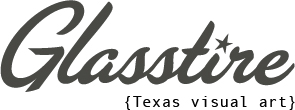The artist’s workspace is anti-entropic — a place where things fall apart and reform, eventually giving way to something new. Visiting the studio offers viewers a glimpse of the line of inquiry behind the finished works. Material scraps, visual references, and unfinished pieces offer context while exposing vulnerabilities of exploration and conceptual risk-taking.
This past fall, artist Willie Binnie worked at the Chinati Residency in Marfa, Texas. His solo exhibition, Marfa, at Keijsers Koning in Dallas, TX features five large-scale paintings, primarily from his residency, along with a thoughtful display of related pieces. Installed to evoke the atmosphere of his Chinati studio, the exhibition pairs these canvases with smaller unframed works on paper scattered throughout the gallery and a central table displaying found objects and nearly 200 Polaroids. The complementary elements serve as a tangible record of his experience and provide insights into his method, allowing the audience to see how his time in West Texas informs this new body of work.

Willie Binnie, “The Chihuahuan Polaroids,” 2024, 189 unique Polaroid photographs, 4.2 x 3.5 inches each
The Polaroids capture the blinding, hot light of the American desert, their overexposed, yellowed surfaces evoking the folkloric frontier. From the desolate terrain emerge images of gas stations, snakes, cacti, and abstracted architectural forms, recalling classic motifs of Western films. In both color and black-and-white, the photographs reveal intentional manipulations in exposure, heightening their aged appearance and emphasizing the immediacy of the medium. Through these decisions, the romanticism of this iconic setting pervades the snapshots, grounding the viewer in the region’s cinematic and mythological allure.

Willie Binnie, “Border (Global South Colorized),” 2024, acrylic stain and walnut ink on canvas, 100.5 x 86.5 inches
Although Binnie’s canvases do not directly draw from these photos, they echo their harsh light and solitary focus. The paintings contain layers of diffused, fluid washes that imply age and atmosphere. Centralized subjects — rendered with pictorial clarity — stand out against muted fields, juxtaposing precision with hazy, dreamlike backdrops. In Black Sun, a crisp black circle anchors the composition, suggesting an eclipsed sun or a black hole. Soft, smoky forms converge and pull away from the edges, creating a rhythm reminiscent of clouds or ash. The imagery feels both cosmic and deeply terrestrial, hinting at an underlying discord. Are we gazing through a gathering of clouds against an ominous sun, or looking from the bottom of a deep well? This ambiguity is heightened by the contrast between the sharp-edged, carefully painted central circle set against loose blooms of clouds, formed through staining rather than precise delineation. This balance of control is at play in all the large-scale works as moments of photographic concentration are positioned against swathes of material invention. The gravity of a tightly depicted concrete snowman interrupts the fluid, forming ground, while a crisp street sign marking the Mexico and US border stands out against soft, yellow-hued fields of pigmented canvas.

Willie Binnie, “Ice (No Ice), Dollar General, Marfa, September 2024 I,” 2024, acrylic on paper, 10.6 x 13.8 inches
There is a clear relationship between the ephemeral, atmospheric ground in the paintings and the Polaroids, where both lose definition. The interplay creates a gentle patina — restrained palettes dominated by grays and faded hues. If the Polaroids frame the ambiance within the canvases, the tight rendering of each painting’s subject is echoed in the small works on paper scattered throughout the gallery. A series of ice machines, notably empty of ice, and a fractured crater occupy the space. On the periphery, an ascending display of hot air balloons — rising with smiley and frowny faces — hints at deeper tensions beneath their playful appearance. These balloons patrol the area, equipped with heat-seeking devices that track movement across the border and alert authorities. The painting, Missile Crater (Gaza) I, is taken from the surrounding area but the title holds broader implications. Rendered with stark precision, these watercolor-like paintings suggest underlying themes within the larger works, resonating with the sharp focus of their subjects.
The pieces within the exhibition mainly exist within a tightly formed loop; they begin and end within a short interval, a brief time in the fall. There is a truth and immediacy in the Polaroids that reverberates through the smaller works, illuminating the observational nature of Binnie’s practice and the insights that shape the final creations. If the paper works hint at a political motive, that suggestion does not fully define itself in the paintings. Instead, these elements converge in a formal and material tension that unsettles the image. The installation — positioning studies alongside the finished compositions — disrupts their stillness, presenting them as part of a broader process rather than isolated entities. By framing the art within its making, Marfa invites viewers to reconsider the boundaries between creation and resolution.
Marfa is on view at Keijsers Koning through February 8.






